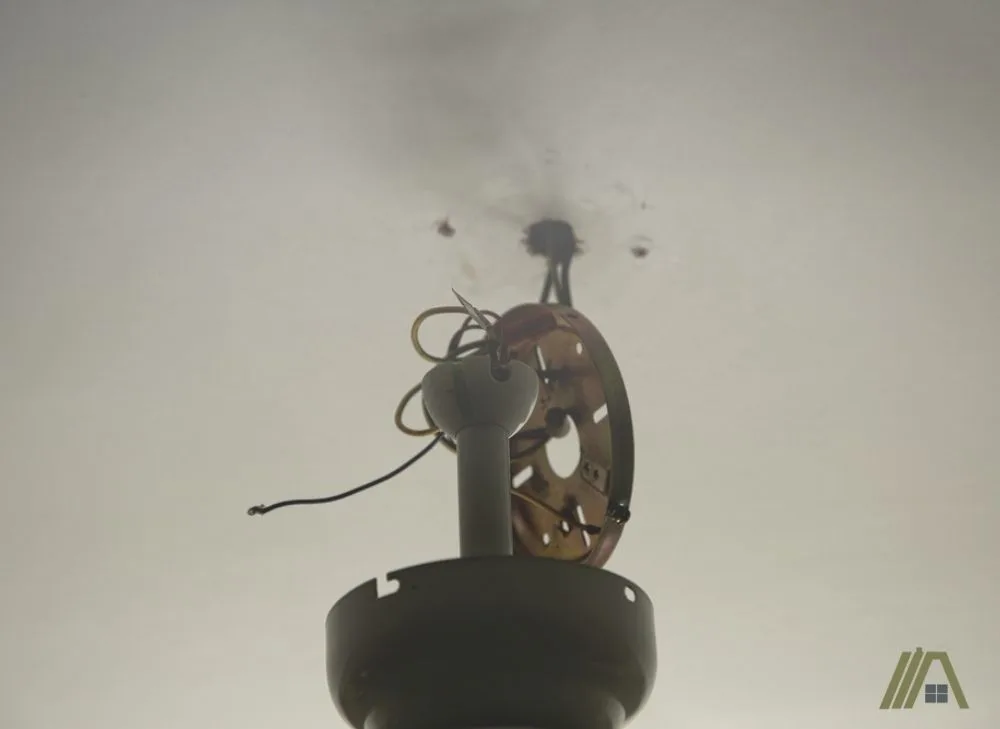Okay, let’s be straight, I know why you’re here reading this article. Don’t do it. Steps are taken to ensure that ceiling fans are securely fixed in the ceiling. However, even if these securities over-compensate for the weight of a fan, they do not do so to the tune of a ceiling fan plus a human body.
If you’re still considering taking a spin or if you have an alternative reason for asking this question (let us know what that reason is—we’re genuinely interested!), then take a look at the evidence of why this is not a good idea.

Ceiling fans aren’t designed to hold a person. Blades can break and fans can fall. On average, humans weigh 180 lbs. Typically, the boxes holding the fans in the ceiling are only able to carry up to 75 lbs. Most people would hang from the blades but these aren’t made to hold as much weight as the box.
What Determines the Weight Ceiling Fans Can Hold?
Ceiling Junction Box
Ceiling boxes are an important component in ceiling fan installations. They provide anchorage for the fan and support its weight as well as house all the respective wiring that comes along with it.
Normal light junction boxes may be acceptable for some lighter fans, but it’s usually best to invest in a ceiling fan-rated box. If you have a junction box already installed but you are unsure if it is fan-rated, then there are a number of ways you can confirm the box rating.
There are different ceiling junction boxes that would be able to support different weights. These ceiling fan boxes are tested and rated by their respective manufacturers according to the prevailing standard.
All ceiling fixtures must be UL-listed (making sure that the product is safe to use). This is the standard alluded to above. However, most fan boxes can support weights of up to 75 lbs.
Subtract the actual weight of the fan from this amount and you are unlikely to end up with your body weight.
Is the Fan Mounted Correctly?
In addition to ensuring the junction box is appropriate when installing a new ceiling fan, it’s also important to do the installation in the correct way. Ceiling fans have to be attached to the ceiling studs in some way.
The junction box can be screwed directly into a conveniently located stud. When you are without a conveniently located stud, you can use a ceiling fan brace specifically designed to solve this problem. This brace allows for extra weight support and provides stability once secured to the joists with screws.
Now, I will say here that the junction box should be so securely fixed to the stud that you should be able to hold onto it and shift your weight from your legs to your arms (not lifting your legs off the floor, though) without it budging.
However, this still does not mean that a ceiling fan can hold a person. When doing the test, the person’s full weight is not being applied, the extra weight is applied in a non-sustained manner, and the junction box and stud are holding the excess weight, not the ceiling fan.
Weight of the Ceiling Fan
Ceiling fans can, on average, weigh between 12 lbs and 50 lbs when it is fully assembled. Their weight is directly proportional to their diameter, so the larger the diameter, the heavier the ceiling fan will be.
There is still room for roughly an additional 25 lbs before the ceiling fixtures can no longer support the fan. However, we also need to consider the extra stresses that ceiling fans produce when they rotate and any additional weight will risk the integrity of the fixture box.
Most Ceiling Fans Cannot Hold a Person
As mentioned, the average weight a ceiling fan can hold depends on the rating of the junction box being used. When a ceiling fan is not on it can hold a little more weight than it can when it is on. The vibration and the downward force of the fan when it is rotating add extra weight or stress rather to the ceiling fixture.
The junction box can handle the weight; however, the actual fan itself is not capable of carrying such weights. To try and hang on a ceiling fan can be dangerous for two reasons.
1. Blades Can Break
Ceiling fan blades are usually made of various materials like metal, wood, and plastic and are held to the body of the fan by blade holders.
These materials are generally very durable when they are in thickened pieces. But they may not be as durable when they are made into blades that are thinned out and have weak spots and can easily be broken or bent.
Blade brackets may also break as they are not able to withstand the extra downward pressure on the blade.
2. Ceiling Fans Can Fall
It is very difficult to test how much weight a ceiling fan can bear, but adhering to the ratings of your fixture is the best place to start.
An adult human being can weigh on average about 180 lbs, which is way more than what most ceiling fixtures are designed to accommodate, and that excludes the actual weight of the fan.
If a person decides to dangle from a ceiling fan it will likely fall due to the overbearing weight and it can cause serious injury to the person and anyone beneath it.
Don’t forget that the fan may be pulled loose and then only fall the next time you put it on or at any random time.

Sources
https://www.thespruce.com/electrical-switch-and-junction-boxes-1824666
https://experthomereport.com/how-much-weight-a-ceiling-fan-can-hold-complete-guide/

